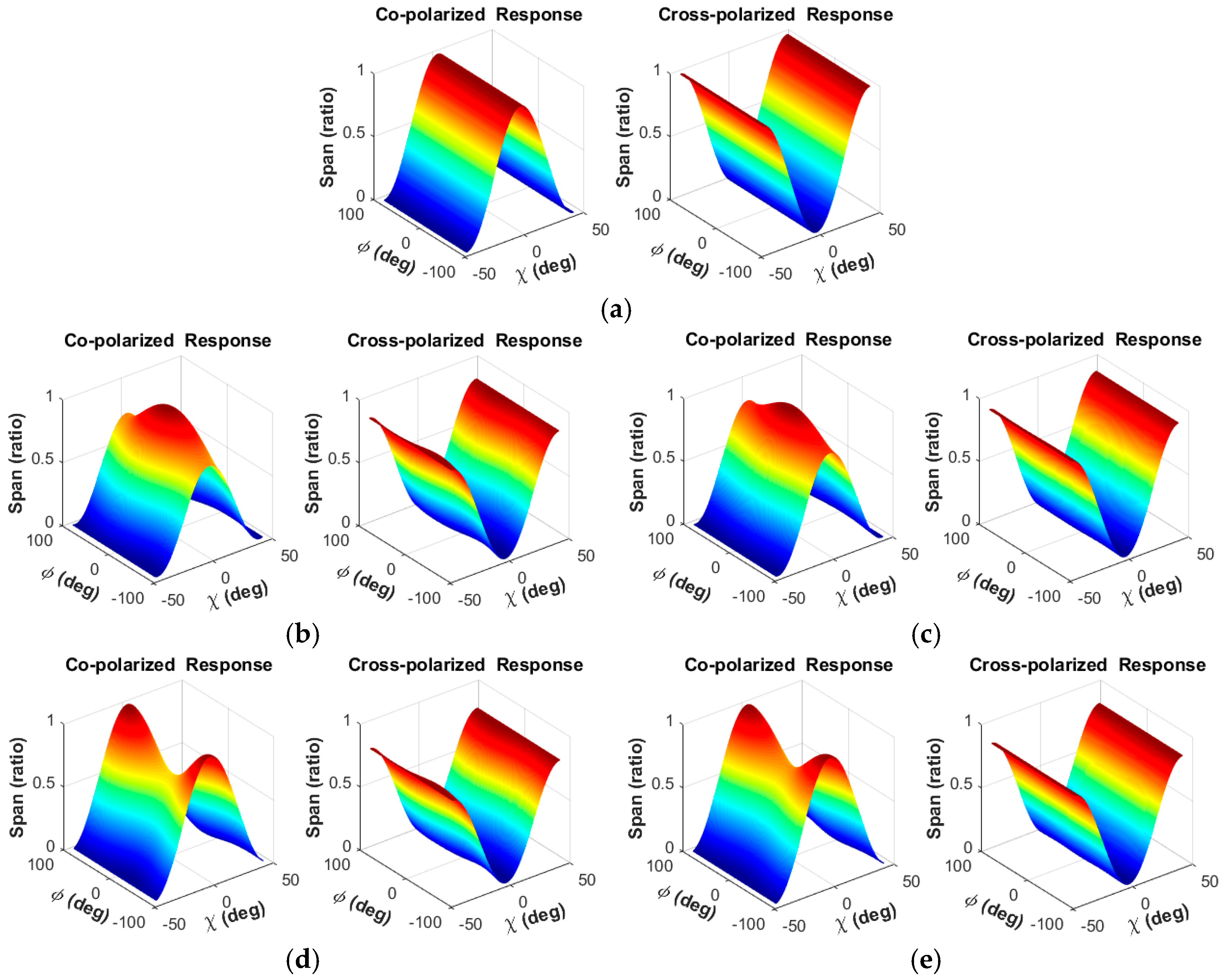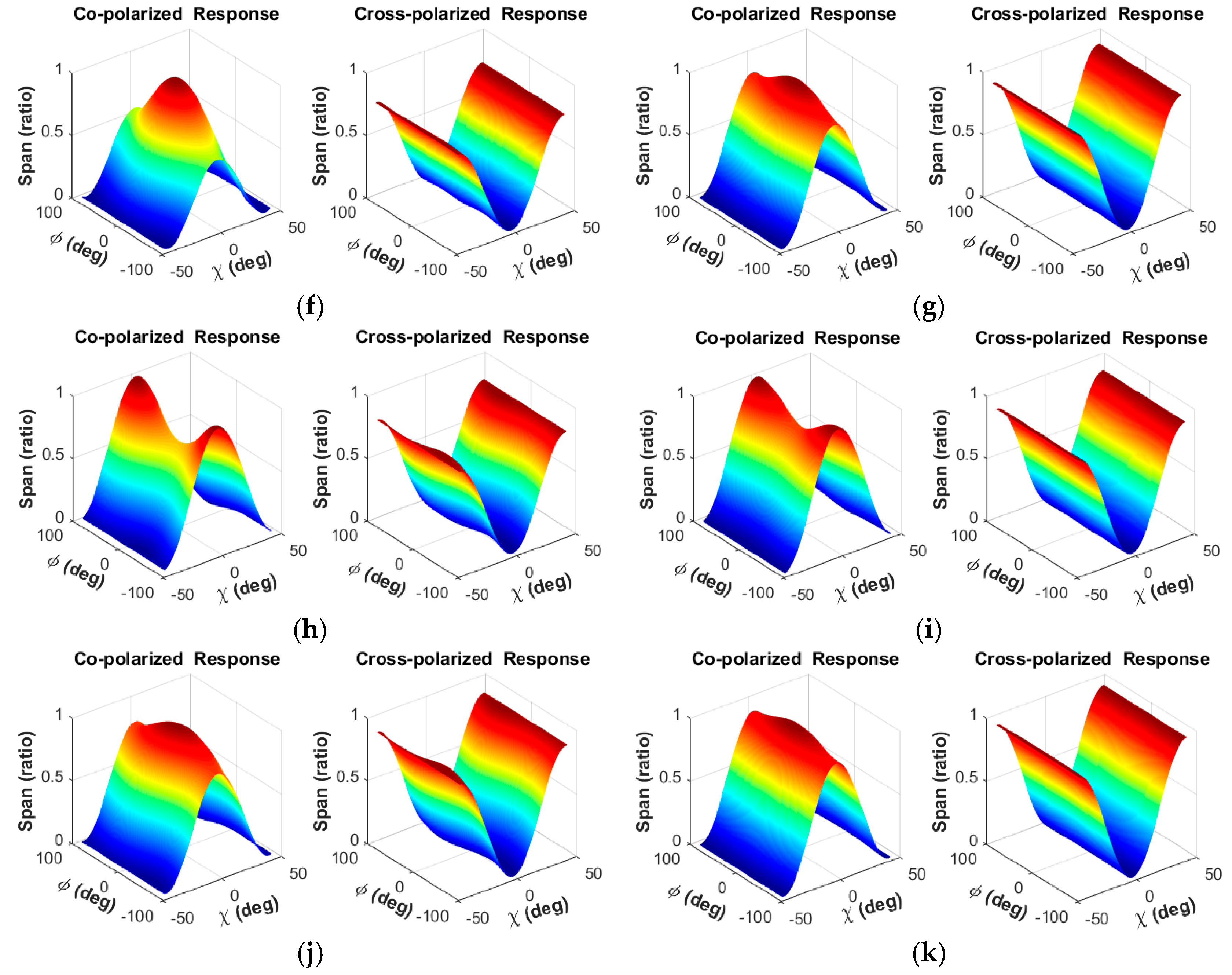Polarimetric Calibration and Quality Assessment of the GF-3 Satellite Images
Abstract
:1. Introduction
2. Polarimetric Error Analysis for the GF-3 Satellite
2.1. Crosstalk Error
2.2. Channel Imbalance Error
2.3. Faraday Rotation Error
2.4. Random System Noise Error
2.5. QualifyValue Adjustment
3. Calibration Method and Processing
3.1. PolCAL Method Based on Reflection Symmetry
3.2. PolCAL Method Based on Scattering Reciprocity
4. Experiments
4.1. Experimental Data
4.2. Experimental Design
4.3. Experimental Results and Analysis
5. Conclusions
Acknowledgments
Author Contributions
Conflicts of Interest
References
- Zhang, Q. System design and key technologies of the GF-3 satellite. Acta Geod. Cartogr. Sin. 2017, 46, 269–277. [Google Scholar]
- Qingjun, Z.; Yadong, L. Overview of chinese first c band multi-polarization SAR satellite GF-3. Aerosp. China 2017, 3, 22–31. [Google Scholar]
- Wang, C.; Liao, G.; Zhang, Q. First spaceborne SAR-GMTI experimental results for the chinese gaofen-3 dual-channel SAR sensor. Sensors 2017, 17, 2683. [Google Scholar] [CrossRef] [PubMed]
- Zhao, J.; Yang, J.; Lu, Z.; Li, P.; Liu, W.; Yang, L. A novel method of change detection in bi-temporal polSAR data using a joint-classification classifier based on a similarity measure. Remote Sens. 2017, 9, 846. [Google Scholar] [CrossRef]
- Van Zyl, J.J. Synthetic Aperture radar Polarimetry; John Wiley & Sons: New York, NY, USA, 2011; Volume 2. [Google Scholar]
- Yin, J.; Yang, J.; Zhang, Q. Assessment of GF-3 polarimetric SAR data for physical scattering mechanism analysis and terrain classification. Sensors 2017, 17, 2785. [Google Scholar] [CrossRef] [PubMed]
- Canadian Space Agency. Available online: http://www.asc-csa.gc.ca/eng/satellites/radarsat/radarsat-tableau.asp (accessed on 27 January 2018).
- Calibration Result of ALOS-2. Available online: http://www.eorc.jaxa.jp/ALOS-2/en/calval/calval_index.htm (accessed on 27 January 2018).
- Shimada, M. Model-based polarimetric SAR calibration method using forest and surface-scattering targets. IEEE Trans. Geosci. Remote Sens. 2011, 49, 1712–1733. [Google Scholar] [CrossRef]
- Chang, Y.; Yang, J.; Li, P.; Zhao, L.; Shi, L. Sample extraction based on helix scattering for polarimetric SAR calibration. ISPRS Inter. Arch. Photogramm. Remote Sens. 2017, XLII-2/W7, 689–692. [Google Scholar] [CrossRef]
- Whitt, M.W.; Ulaby, F.T.; Polatin, P.; Liepa, V.V. A general polarimetric radar calibration technique. IEEE Trans. Antennas Propag. 1991, 39, 62–67. [Google Scholar] [CrossRef]
- Sarabandi, K. Calibration of a polarimetric synthetic aperture radar using a known distributed target. IEEE Trans. Geosci. Remote Sens. 1994, 32, 575–582. [Google Scholar] [CrossRef]
- Shi, L.; Yang, J.; Li, P. Co-polarization channel imbalance determination by the use of bare soil. ISPRS J. Photogramm. Remote Sens. 2014, 95, 53–67. [Google Scholar] [CrossRef]
- Villa, A.; Iannini, L.; Giudici, D.; Monti-Guarnieri, A.; Tebaldini, S. Calibration of SAR polarimetric images by means of a covariance matching approach. IEEE Trans. Geosci. Remote Sens. 2015, 53, 674–686. [Google Scholar] [CrossRef]
- Luscomb, A.P. Polarimetric parameter estimation from amazon images. In Proceedings of the CEOS WGCV- SAR Workshop 2001, Tokyo, Japan, 2–5 April 2001; Available online: ftp://ftp.eorc.jaxa.jp/cdroms/EORC-061/data/f_papers/ceos078.pdf (accessed on 27 January 2018).
- Ainsworth, T.L.; Ferro-Famil, L.; Lee, J.-S. Orientation angle preserving a posteriori polarimetric SAR calibration. IEEE Trans. Geosci. Remote Sens. 2006, 44, 994–1003. [Google Scholar] [CrossRef]
- Woodhouse, I.H. Introduction to Microwave Remote Sensing; CRC press: Boca Rtaon, FL, USA, 2005. [Google Scholar]
- Xu, F.; Wang, H.; Jin, Y.-Q.; Liu, X.; Wang, R.; Deng, Y. Impact of cross-polarization isolation on polarimetric target decomposition and target detection. Radio Sci. 2015, 50, 327–338. [Google Scholar] [CrossRef]
- Recommendations from CEOS CAL/VAL 2004. Available online: http://earth.esa.int/workshops/ceos_sar_2004/recommendation_at_ceos_cal.html (accessed on 27 January 2018).
- Wang, C.; Yu, W.; Wang, Y.; Yan, H. Polarimetric calibration requirements on several classification schemes for land application of polarimetric synthetic aperture radar. IET Radar Sonar Navig. 2013, 7, 113–122. [Google Scholar] [CrossRef]
- Kimura, H. Calibration of polarimetric palsar imagery affected by faraday rotation using polarization orientation. IEEE Trans. Geosci. Remote Sens. 2009, 47, 3943–3950. [Google Scholar] [CrossRef]
- Fore, A.G.; Chapman, B.D.; Hawkins, B.P.; Hensley, S.; Jones, C.E.; Michel, T.R.; Muellerschoen, R.J. Uavsar polarimetric calibration. IEEE Trans. Geosci. Remote Sens. 2015, 53, 3481–3491. [Google Scholar] [CrossRef]
- Bickel, S.H.; Bates, R.H.T. Effects of magneto-ionic propagation on the polarization scattering matrix. Proc. IEEE 1965, 53, 1089–1091. [Google Scholar] [CrossRef]
- Quegan, S.; Lomas, M.R. The interaction between faraday rotation and system effects in synthetic aperture radar measurements of backscatter and biomass. IEEE Trans. Geosci. Remote Sens. 2015, 53, 4299–4312. [Google Scholar] [CrossRef]
- Lee, J.-S.; Pottier, E. Polarimetric Radar Imaging: From Basics to Applications; CRC Press: Boca Raton, FL, USA, 2009; pp. 66–72. [Google Scholar]
- Kimura, H.; Mizuno, T.; Papathanassiou, K.P.; Hajnsek, I. Improvement of polarimetric SAR calibration based on the quegan algorithm. In Proceedings of the 2004 IEEE International Geoscience and Remote Sensing Symposium, Anchorage, AK, USA, 20–24 September 2004; Volume 1, pp. 184–187. [Google Scholar]
- Quegan, S. A unified algorithm for phase and cross-talk calibration of polarimetric data-theory and observations. IEEE Trans. Geosci. Remote Sens. 1994, 32, 89–99. [Google Scholar] [CrossRef]
- Agrawal, A.P.; Boerner, W.-M. Redevelopment of kennaugh’s target characteristic polarization state theory using the polarization transformation ration formalism for the coherent case. IEEE Trans. Geosci. Remote Sens. 1989, 27, 2–14. [Google Scholar] [CrossRef]
- Chen, J.; Guo, W.; Li, Z.; Liu, W. Optimised limit for polarimetric calibration of fully polarised sar systems. Electron. Lett. 2016, 52, 763–764. [Google Scholar] [CrossRef]


| Imaging Mode | Incidence Angle (◦) | Look Number | Resolution (m) | Imaging Width (km) | Polarization Mode | |
|---|---|---|---|---|---|---|
| Spotlight | 20~50 | 1 × 1 | 1 | 10 | Selective single-polarization | |
| Ultra-fine strip | 20~50 | 1 × 1 | 3 | 30 | Selective single-polarization | |
| Fine strip I | 19~50 | 1 × 1 | 5 | 50 | Selective dual-polarization | |
| Fine strip II | 19~50 | 1 × 2 | 10 | 100 | Selective dual-polarization | |
| Standard strip | 17~50 | 3 × 2 | 25 | 130 | Selective dual-polarization | |
| Narrow scan | 17~50 | 1 × 6 | 50 | 300 | Selective dual-polarization | |
| Wide scan | 17~50 | 1 × 8 | 100 | 500 | Selective dual-polarization | |
| global | 17~53 | 2 × (2~4) | 500 | 650 | Selective dual-polarization | |
| Full-polarimetric strip I | 20~41 | 1 × 1 | 8 | 30 | full-polarization | |
| Full-polarimetric strip II | 20~38 | 3 × 2 | 25 | 40 | full-polarization | |
| Wave imaging | 20~41 | 1 × 2 | 10 | 5 | full-polarization | |
| Extend | Incidence angle I | 10~20 | 3 × 2 | 25 | 130 | Selective dual-polarization |
| Incidence angle II | 50~60 | 3 × 2 | 25 | 80 | Selective dual-polarization | |
| Imaging Region | Acquisition Date | Image ID | Central Look Angle | Image Size (Pixels) |
|---|---|---|---|---|
| Etuoke Banner | 12 June 2017 | 0002441640 | 39.98 | 5881*4717 |
| 0002441641 | 39.97 | 5778*4717 | ||
| 24 June 2017 | 0002441191 | 43.92 | 7001*6161 | |
| 0002441190 | 43.91 | 7054*6161 | ||
| 06 July 2017 | 0002463755 | 47.45 | 3775*5977 | |
| 0002463754 | 47.44 | 3814*5977 | ||
| 11 July 2017 | 0002475549 | 40.01 | 6165*4708 | |
| 0002475550 | 40.01 | 6206*4708 | ||
| 16 July 2017 | 0002491702 | 30.43 | 6770*7182 | |
| 0002491701 | 30.43 | 6778*7182 | ||
| Wuhan | 30 April 2017 | 0002335427 | 36.21 | 7982*6200 |
| 30 April 2017 | 0002335421 | 36.22 | 7944*6200 | |
| 24 August 2017 | 0002559955 | 36.15 | 7464*6209 | |
| 02 October 2017 | 0002645747 | 37.54 | 5821*5959 |
| Image ID | Crosstalk-Sym. (dB) | Crosstalk-Rec. (dB) | |α| (dB) | Arg(α) (deg.) | |k| (dB) | Arg(k) (deg.) | SNR (dB) |
|---|---|---|---|---|---|---|---|
| 0002441640 | |||||||
| 0002441641 | |||||||
| 0002441191 | |||||||
| 0002441190 | |||||||
| 0002463755 | |||||||
| 0002463754 | |||||||
| 0002475549 | |||||||
| 0002475550 | |||||||
| 0002491702 | |||||||
| 0002491701 | |||||||
| 0002335427 | |||||||
| 0002335421 | |||||||
| 0002559955 | |||||||
| 0002645747 |
| Image ID | Crosstalk-Sym. (dB) | Crosstalk-Rec. (dB) | |α| (dB) | Arg(α) (deg.) | |k| (dB) | Arg(k) (deg.) | SNR (dB) |
|---|---|---|---|---|---|---|---|
| 0002441640 | |||||||
| 0002441641 | |||||||
| 0002441191 | 0.3 | ||||||
| 0002441190 | |||||||
| 0002463755 | |||||||
| 0002463754 | - | ||||||
| 0002475549 | |||||||
| 0002475550 | |||||||
| 0002491702 | |||||||
| 0002491701 | |||||||
| 0002335427 | |||||||
| 0002335421 | |||||||
| 0002559955 | |||||||
| 0002645747 |
© 2018 by the authors. Licensee MDPI, Basel, Switzerland. This article is an open access article distributed under the terms and conditions of the Creative Commons Attribution (CC BY) license (http://creativecommons.org/licenses/by/4.0/).
Share and Cite
Chang, Y.; Li, P.; Yang, J.; Zhao, J.; Zhao, L.; Shi, L. Polarimetric Calibration and Quality Assessment of the GF-3 Satellite Images. Sensors 2018, 18, 403. https://doi.org/10.3390/s18020403
Chang Y, Li P, Yang J, Zhao J, Zhao L, Shi L. Polarimetric Calibration and Quality Assessment of the GF-3 Satellite Images. Sensors. 2018; 18(2):403. https://doi.org/10.3390/s18020403
Chicago/Turabian StyleChang, Yonglei, Pingxiang Li, Jie Yang, Jinqi Zhao, Lingli Zhao, and Lei Shi. 2018. "Polarimetric Calibration and Quality Assessment of the GF-3 Satellite Images" Sensors 18, no. 2: 403. https://doi.org/10.3390/s18020403





